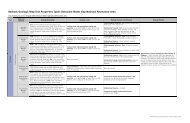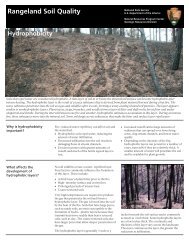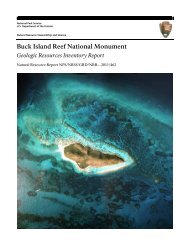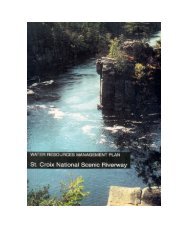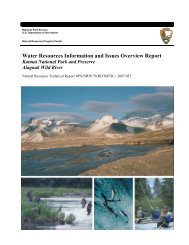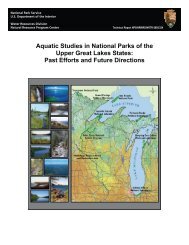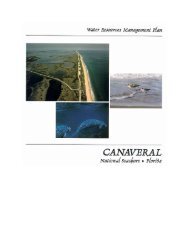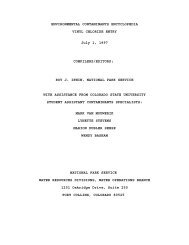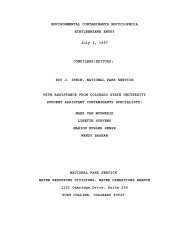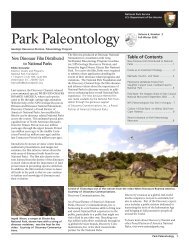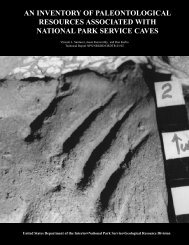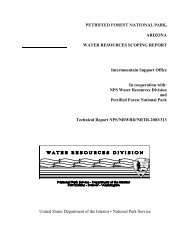Naphthalene, C1 - National Park Service
Naphthalene, C1 - National Park Service
Naphthalene, C1 - National Park Service
Create successful ePaper yourself
Turn your PDF publications into a flip-book with our unique Google optimized e-Paper software.
purposes, or to determine if biodegradation has occurred, the NOAA<br />
expanded scan for PAHs and alkyl PAHs [828], or equivalent<br />
improvements, should be used since such scans generally give more<br />
rigorous and comprehensive results than the unmodified EPA scans.<br />
The NOAA scan also covers this alkyl (<strong>C1</strong>) naphthalene.<br />
Most of the historically used methods for PAHs, including EPA<br />
standard semi-volatile scan numbers 8270 and 610, do not cover<br />
important alkyl PAHs (such as this one) and do not utilize lowenough<br />
detection limits.<br />
Recommended detection limits: 10 ppt for water, 0.3 to 1 ppb<br />
for tissues, sediments, and soil.<br />
Note: Utilizing up to date techniques, many of the better<br />
labs can use detection limits of 0.3 to 1 ppb for<br />
tissues, sediments, and soils, and these lower detection<br />
limits are far better for risk or hazard assessment, but<br />
in all cases detection limits for these media should not<br />
be above 10 ppb.<br />
Recent (1991) studies have indicated that EPA approved methods<br />
used for oil spill assessments (including total petroleum<br />
hydrocarbons method 418.1, semivolatile priority pollutant organics<br />
methods 625 and 8270, and volatile organic priority pollutant<br />
methods 602, 1624, and 8240) are all inadequate for generating<br />
scientifically defensible information for Natural Resource Damage<br />
Assessments [468]. These general organic chemical methods are<br />
deficient in chemical selectivity (types of constituents analyzed)<br />
and sensitivity (detection limits); the deficiencies in these two<br />
areas lead to an inability to interpret the environmental<br />
significance of the data in a scientifically defensible manner<br />
[468]. If a <strong>Park</strong> <strong>Service</strong> groundwater investigation at Colonial<br />
<strong>National</strong> Historical <strong>Park</strong> performed in response to contamination by<br />
Fuel Oil 5 had utilized EPA semi-volatile scan 8270 or any of the<br />
other typical EPA scans (625, etc.) all of which only include<br />
parent compounds and typically utilize detection limits in the 170-<br />
600 ppb range, the false conclusion reached would have been that no<br />
PAHs were present in significant (detection limit) amounts. This<br />
false negative conclusion would have been made because the parent<br />
compound PAHs present constituted only 7.6% of the PAHs detected in<br />
groundwater by the expanded scan [828], and the highest<br />
concentration found for any parent compound was 8.4 ppb, far below<br />
the detection limits used on the older standard EPA scans.<br />
Utilizing the NOAA protocol expanded scan [828], it was determined<br />
that 92.4% of the total concentration values of the PAHs detected<br />
in groundwater were alkyl PAHs, and that all 39 PAHs and alkyl PAHs<br />
were present. Of course, all 39 PAHs were also present in the<br />
fresh product, in much higher concentrations, and also having alkyl<br />
compounds with the highest percentage of higher values compared to<br />
parent compounds (see Chem.Detail section in PAHs entry for more<br />
details).<br />
In a similar vein, if the <strong>Park</strong> <strong>Service</strong> sediment investigation<br />
at Petersburg <strong>National</strong> Historical Battlefield (see Chem.Detail



